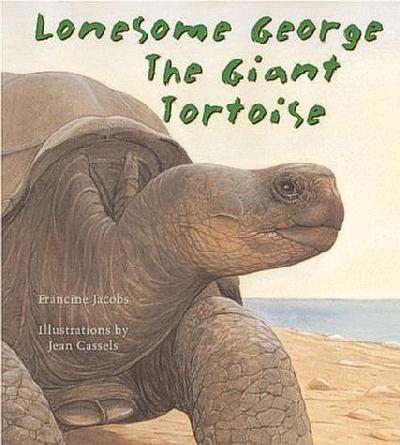 |
| Publisher: Walker & Company |
|
Our Winning Book Synopsis:
This book tells the true story of Lonesome George, the last living Pinta Island giant tortoise, from his search for food, shelter, and a mate on that Galopagos Island, to his days at the Charles Darwin Research Station on a nearby island, where scientists are encouraging George to mate--as yet, without success.
This children's science picture book is special for many reasons. It tells the story of a 200-pound giant desert tortoise whose Pinta Island habitat and food supply was overwhelmed by the descendants of goats brought ashore by fishermen. It shows the "potentially devastating effects of introducing nonindigenous animals into a habitat" (Oliver, 2003).
In fact, the island was thought for decades to have no giant tortoises left at all, until game wardens who were attempting to rid the island of goats stumbled across George. To protect George, the wardens placed him into a hammock-type carrier and took him to Santa Cruz Island.
There, at the Charles Darwin Research Station, he was placed into a large and pleasant exhibit pen, cared for well, and the world's news media dubbed him "the loneliest creature on Earth." From there, scientists began a worldwide search for a female Pinta Island giant tortoise, because George had steadfastly refused to mate with females from any of the other Galapagos Islands. They searched Pinta Island again, but without the goats present, the plants had grown back thick, so finding any tortoise there now became even more of a challenge.
We enjoy the turtle's-eye views and interesting perspectives of George and his desert habitat that illustrator Cassels created for this book. Her artistic images, in Tuftian earth tones, work well with the simple but moving text that author Francine Jacobs has penned. It should be noted that Cassels has illustrated over 50 children's books and it shows--every page of this book is life-like and seems to invite the child to step inside the tortoise's world.
The predicaments Jacobs poses make George's story compelling, as well as ecologically informative. Yet, one never gets the feeling this is a mini science textbook. There is no dull scientific prose. All the reader cares about is Lonesome George, and his difficult desert life. This is as it should be.
What makes this book "work" visually? The book's end papers show a set of carefully designed and colored maps that zoom-in on the Galapagos Islands (which belong to Ecuador in South America) to show where the story takes place. Most of the pages are full-page spreads with sparse text, ideal for children's visual-verbal cognition. There are lots of close-up views to personalize the story and highlight anatomical features. The close-up of George eating an Opuntia cactus pad shows him swallowing it, sharp spines and all! Later we learn that's how he gets his fresh water when there are no rain puddles present.
On another occasion, we see the ecological relationship between George and five ground finches that clean his skin of insects and seeds.
When George burrows under the brush to escape the hot, mid-day sun, we are "down low" with him and we can almost feel what it would be like to nap there with him!
Once, when George accidentally rolls over, we struggle with him as he finally rights himself and thus escapes certain death. We also commiserate with him when he is unable to find a mate--while he sees marine animals along the coast who have no such problem.
These two story-tellers have made this tortoise's life exciting and personal. They have taught us some principles of plant disturbance ecology, plant-animal interactions, introduction of non-native species, wildlife management, animal behavior, adaptation, animal locomotion, thermoregulation, plant and animal conservation, and extinction. It also lays the groundwork for the child's later need to understand reproductive genetics. The last sentence is a sentence of hope: "With luck, George won't be lonesome anymore."
The book also contains a photo of the author herself at the actual Charles Darwin Research Station on Santa Cruz Island, showing she has made the heroic effort to understand 80-year-old George's life and habitat firsthand.
The book ends with a fact page about the Galapagos giant tortoises, and it offers two web sites that the reader can visit to learn more about George and the giant tortoises http://www.galapagos.org and http://www.darwinfoundation.org
The Galapagos Islands are like no place else on Earth. They have stimulated important biological thought. Future generations need to know about them and wonder at them too. This book helps to insure that they will. Jacobs and Cassels have made an important contribution to children's literature, visual-verbal communication, and to biology education with this book. This is a book that children will want to read and look at again and again.
|